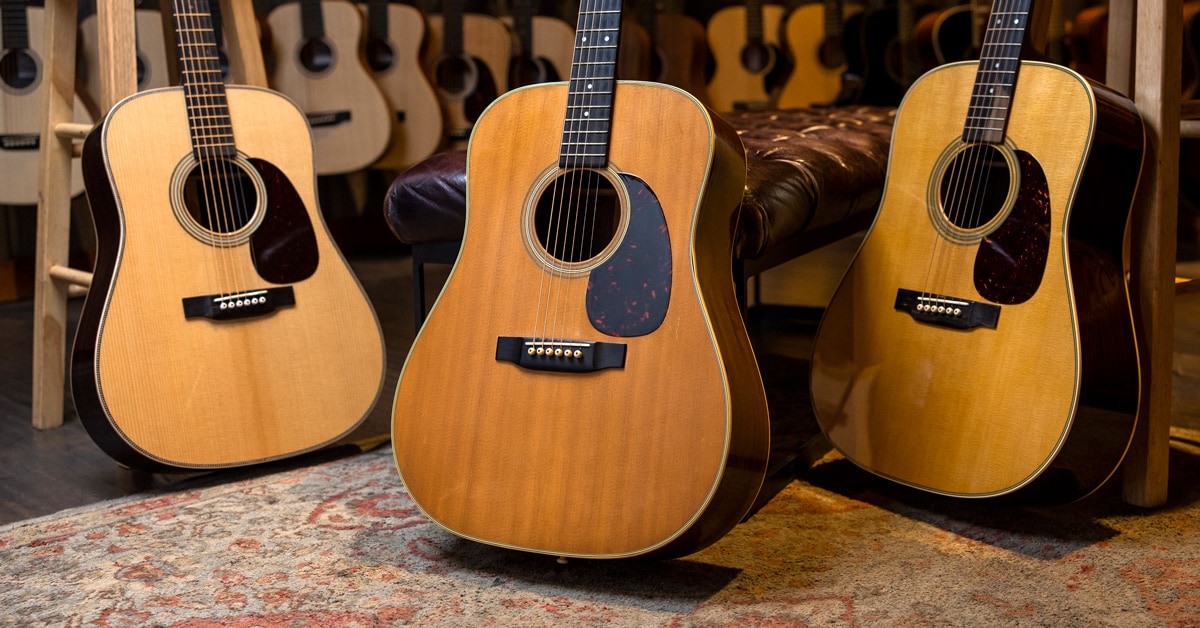What do Noel Gallagher, Hank Williams, Sturgill Simpson, John Frusciante, Bob Dylan, Jimmy Page, Brad Paisley, Father John Misty, Michael Hedges and Joni Mitchell have in common? They all play, or have played, a Martin D-28 acoustic guitar. Since it first appeared in the 1935 C.F. Martin & Company catalog, the big, balanced and articulate sound of the D-28 has made it a consistent top choice for acoustic guitarists across virtually every genre. In this article, we’ll take a look at the history and evolution of the guitar, some key moments along the way to the present day and examine a variety of the current models you can find hanging on the walls of Guitar Center’s Acoustic Rooms across the nation.
Table of Contents
The History of the 28 Style Guitar
Birth of the Dreadnought Acoustic Guitar
The Martin D-28
The Early History of the Martin D-28
The Evolution of the Martin D-28
Moments in Martin D-28 History
Famous Martin D-28 Players
Iconic Songs Featuring the Martin D-28
Martin's Current D-28 Offerings
Closing the Case for the Martin D-28
People Also Ask ...
The History of the 28 Style Guitar
Though an 0-28 guitar appears in the Martin ledgers for $28 as early as 1852, at that time the ledger listings, which predate the first printed catalogs, simply indicated body size and wholesale price ($28 in 1852 would be equivalent to almost $1,100 today for the wholesale price, so this was not an inexpensive guitar). It wouldn’t be for several years yet that the style numbers began to indicate construction and trim details. But by the mid-1870s, Style 28 began its journey toward what we think of today. When it debuted, at a size 0 (sometimes called “concert-size”), the Martin Style 28 was the largest guitar Martin regularly made. There were a handful of 00-size Style 28 guitars built over the next four decades, but they appear to have all been special orders, not a regular model.
While the iconic “5-9-5” rosette was there on the Style 28 from the beginning, the early guitars tended to be fairly plain, as fancy pearl inlays were kept to the smaller-size instruments that were mostly seen as “ladies’ guitars.” It wasn’t until around the turn of the century that the Style 28 was codified with the rosewood back and sides, spruce top, ebony bridge and fingerboard, bound body and neck, herringbone body trim and “zipper” back strip that we think of today as classic prewar features. At that time, necks were still two‑piece Spanish cedar and wouldn’t shift to a single piece of mahogany until the 1920s. But the largest body size available was still 00. For the next stage of evolution, we need to step into the world of contract manufacturing.
Birth of the Dreadnought Acoustic Guitar
From its beginnings, C.F. Martin built guitars for other brands, partnering with retailers like Wurlitzer, Montgomery Ward and Oliver Ditson. In 1916, Martin created the large‑bodied Ditson III model for Oliver Ditson—a guitar Ditson named the “dreadnought” after the mighty British battleship HMS Dreadnought. The large body delivered the volume and presence players sought when accompanying mandolin orchestras. Martin wouldn’t produce a dreadnought under its own name until 1931, and that guitar would be the D‑28.
The Martin D-28
The Early History of the Martin D-28
In 1931, the Ditson company was sold, and the dreadnought body size, which had been exclusive to them, reverted to C.F. Martin & Company. The dreadnought body created a new, louder, fuller and deeper sound than smaller bodies had, with the superior projection needed to be heard in theaters that were devoted to popular entertainments. However, Martin was still somewhat resistant to building what they considered to be a "bass guitar," feeling that the smaller body sizes had a more balanced tone. There was enough demand for the instrument that they built the guitars but refrained from listing the model in their catalog. The first run of D-28s in 1931, in fact, though they all bore the Martin name and a newly created gold headstock logo decal, was sold exclusively to the Chicago Musical Instrument Company. For the next several years, the D-size body was only sold to a handful of specific dealers and to performing artists who knew what to ask for. It would be 1935 before the D-28 officially appeared in Martin's printed catalog and price list. Ever since that debut, it became and has persisted as one of the top-selling premium acoustic guitars around the world.
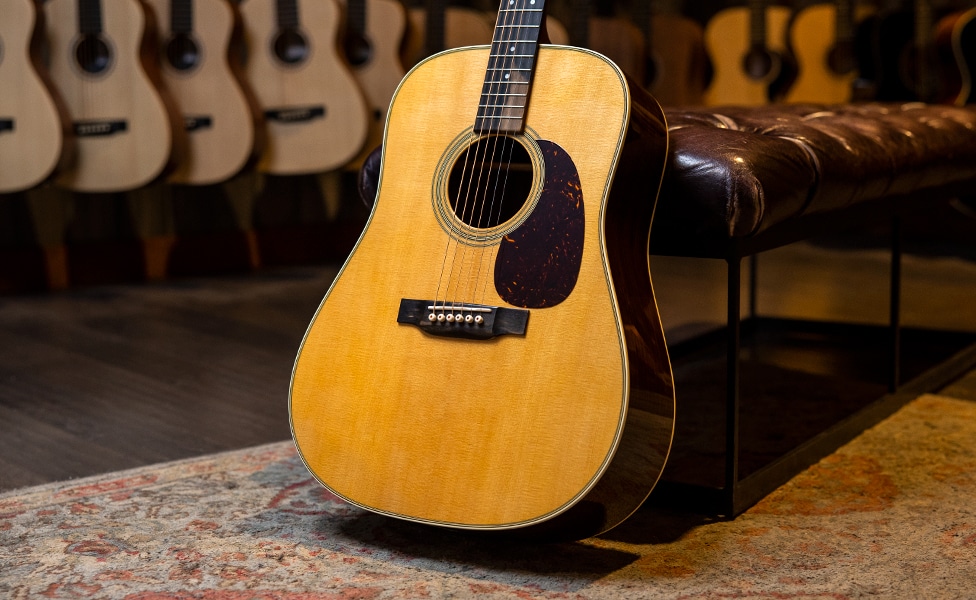
The Martin D-28 has also been one of the most-copied steel-string acoustic guitars ever. Other companies saw the success Martin was having, notably Gibson, who, attempting to go the large dreadnought body one better, introduced the larger, deeper and somewhat louder, round-shouldered Super Jumbo body in 1937. By the 1950s and early 1960s, the folk music boom had companies like Epiphone (the Frontier model) and Guild (the D-40 and D-50, also known as the “Bluegrass Special”) beginning to build dreadnought-style acoustics of their own. But it was the Martin dreadnought that still ruled the roost, thanks to its exceptionally clear articulation and tonal balance.
The Evolution of the Martin D-28
- 1916: Martin builds its first dreadnought-style guitars for Oliver Ditson Co. (models 111, 222, etc.) using large, deep-bodied designs with fan bracing, mahogany backs/sides, and 12-fret necks, marketed under Ditson—not Martin.
- 1916–1921: About 19 Ditson dreadnoughts (style 111) produced, along with some style 222 variants; extremely rare.
- 1924: Martin combines its dreadnought-sized body with X-bracing, replacing fan bracing and enhancing structural strength and tone.
- 1931: Martin launches its first branded dreadnoughts—D‑1 (mahogany; later D‑18) and D‑2 (rosewood; later D‑28). Both sport the inherited 12-fret neck and slotted headstock layout.
- 1934: Standardization to the 14‑fret neck and squarer, shorter body shape occurs—boosting playability and aligning with banjo-playing ergonomics.
- 1935: The D‑28 is featured prominently in Martin’s catalog, with sales momentum picking up.
- 1931: D-28 introduced by Martin (initial runs were 12-fret).
- 1934: Switch to the now-familiar 14-fret body/neck layout.
- 1935: D-28 first appears in Martin’s printed catalog/price list.
- 1938–1939: X-brace moved rearward (from the earlier forward position)—a structural response to heavy strings of the era.
- Late 1944: Scalloped bracing ends; bracing is tapered through the late ’40s, then becomes straight.
- 1944: Fingerboard inlays change from diamonds and squares to dots.
- 1946–1947: Herringbone purfling and backstrip phased out (supply issues); “chainlink”/multi-stripe purfling becomes standard.
- 1946: Tops transition from Adirondack (red) spruce to Sitka spruce.
- 1965: Bridge changes from long through-saddle to short drop-in saddle.
- April 1968: Large rosewood bridge plate replaces the earlier small maple plate (later reversed on many modern/vintage-spec variants).
- 1969: Back/sides wood changes from Brazilian rosewood to East Indian rosewood.
- 1967–1985: Neck reinforcement shifts from steel T-bar to square steel tube (’67), then to adjustable truss rod(’85).
- 2017: “Reimagined” D-28 update adds forward-shifted (non-scalloped) X-bracing plus vintage-style cosmetics (aged toner, antique-white binding, etc.).
Moments in Martin D-28 History
Famous Martin D-28 Players
The list of well‑known D‑28 players is long and varied. Graham Nash of The Hollies was playing a D‑28 before Crosby, Stills, Nash & Young ever formed; both Stephen Stills and Neil Young are longtime devotees, with Young famously owning a prewar herringbone D‑28 that once belonged to Hank Williams. For decades, the D‑28 was the default dreadnought—beloved by folk musicians, country pickers and rock stars alike—to the point that there was a two‑year waiting list for one in the 1950s. John Prine swore by his vintage D‑28 for his fingerpicking, and while Nick Drake is often pictured with a small‑body guitar on the cover of his album Bryter Layter, his main steel‑string acoustic was a D‑28. Today, modern artists, including Noel Gallagher (Oasis and High Flying Birds), James Iha (Smashing Pumpkins), H.E.R., Harry Styles, Sturgill Simpson, Billy Strings and even Jack Black, have all been seen and heard with a Martin D‑28 in hand.
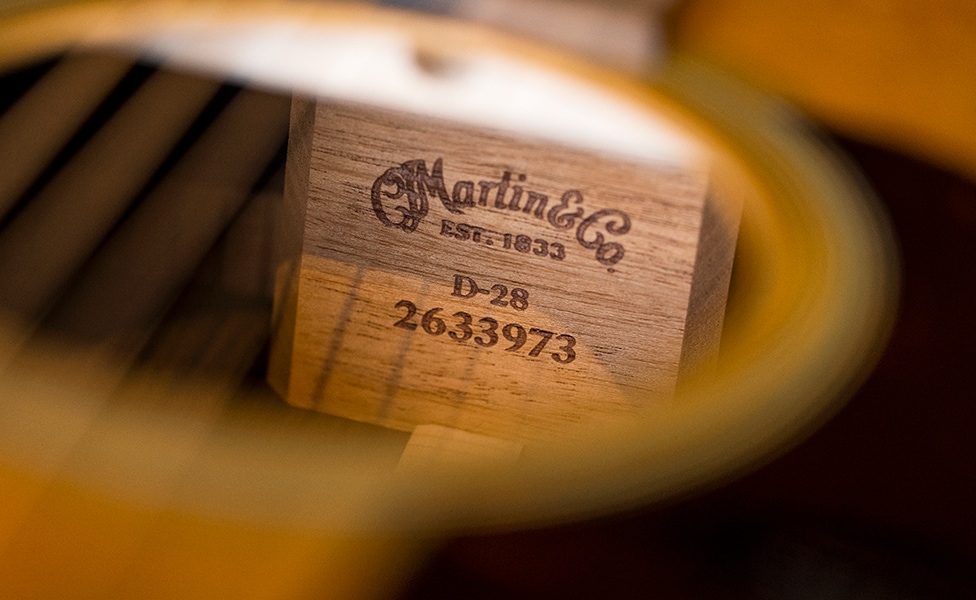
"Wait," you're saying, "what about more modern players?" Noel Gallagher (Oasis and High Flying Birds), James Iha from Smashing Pumpkins, H.E.R., Harry Styles, Sturgill Simpson, Billy Strings, even Jack Black—all are artists who've been seen and heard with their D-28 in hand. And all these artists, classic or new, have put the Martin D-28 to good purpose on record and live.
Iconic Songs Featuring the Martin D-28
There are a lot to choose from, and we’re sure to miss some of your favorites, but here are some highlights from the recorded history of the Martin D-28 acoustic guitar.
The Beatles—"Blackbird" (1968)
Paul McCartney played his D-28 on the folky Beatles classic “Blackbird.” With a catalog as sprawling and spectacular as theirs, “Blackbird” is still often considered one of their most moving and memorable pieces. McCartney also contributed tempo-keeping foot taps to the recording.
Led Zeppelin—"The Rain Song" (1973)
Jimmy Page’s acoustic tracks on “The Rain Song” were recorded with a D-28. A long and winding ballad, Page is believed to have written the song in response to George Harrison’s complaints to John Bonham that Led Zeppelin rarely wrote slow jams. Page has said the song’s first two chords are quoted from the Beatles’ “Something.”
Bob Dylan—"Tangle Up in Blue" (1975)
Dylan barely sets his D‑28 down on Blood on the Tracks, and the album’s single showcases the guitar’s voice.
Vince Gill—"This Old Guitar and Me" (2003)
Vince Gill wrote “This Old Guitar and Me” for his treasured D-28. The song tells the story of purchasing the 1942 model at age 17, traveling the States for years with it by his side and finally retiring the instrument to its case underneath his bed.
Honorable Mentions of Music Featuring the D-28
Mumford & Sons’ “Little Lion Man” features Marcus Mumford’s D‑28; Noel Gallagher used a D‑28 extensively during the 2010s, with “If I Had a Gun” as a prime example; and Colbie Caillat’s “Realize” shows off the guitar’s rich body. There are countless more examples out there to discover.
Martin's Current D-28 Offerings
C.F. Martin & Company currently builds a number of different D-28 versions, from a standard model to the Vintage and Authentic live versions, plus occasional limited editions featuring unique woods or other special features. You can see all the different versions that are currently available in our Martin D-28 collection, but for this article we're going to focus on the main versions that are currently in production.
Martin Standard Series D-28
Why It’s Cool: For over 90 years, the flagship D-28 has equipped artists in country, folk, rock and beyond with an acoustic instrument that truly sings.
Things to Consider:
- High Performance Taper neck carve aids maneuverability
- Punchy midrange carves through any mix
- Lively, dynamic response is ideal for expressive playing
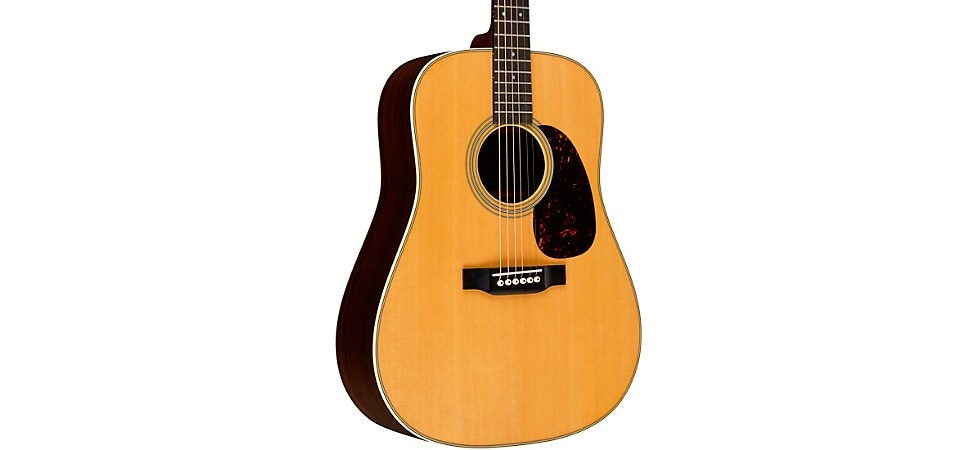
Shop Now: Martin D-28 Standard Dreadnought Acoustic Guitar
The D-28 Standard model is a blend of vintage and modern features. The woods are the classic combination of lively Sitka spruce top, rosewood (East Indian in this case) back and sides and ebony-topped mahogany neck. The top construction brings together the forward-shifted, vintage-style X with non-scalloped braces, for a combination that combines both liveliness and stiffness. The multi-stripe trim and "chainlink" back strip echo the look of the post-WWII D-28s, but the modified oval neck profile gives the instrument a distinctly modern feel.
Martin D-28 Modern Deluxe
Why It’s Cool: The D-28 Modern Deluxe undergoes contemporary treatment methods to capture the experience of playing a treasured vintage acoustic.
Things to Consider:
- Fully matured Martin voice from a modern-built guitar
- Unique appointments include flamed maple binding and gold frets
- Asymmetrical neck profile optimizes comfort up and down the fingerboard
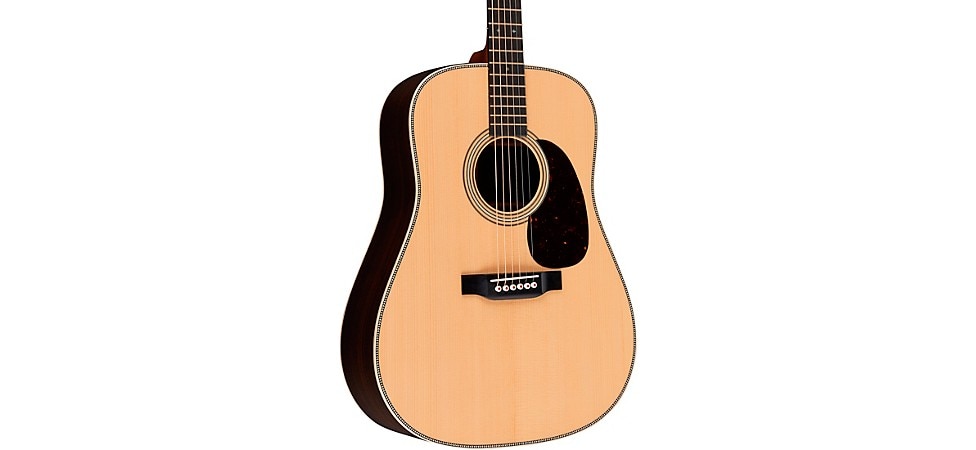
Shop Now: Martin D-28 Modern Deluxe Dreadnought Acoustic Guitar
Martin's Modern Deluxe series is a wonderful combination of vintage and modern guitar building, taking the best from both worlds. The D-28 Modern Deluxe boasts several very special features, beginning with Martin's VTS (Vintage Tone System) top and bracing. VTS uses a carefully applied version of torrefaction (controlled heat treatment in an oxygen-free <anaerobic> environment) to zero in on the aging characteristics of specific vintage guitars in their museum collection. The experts at Martin can pick a guitar, do a deep analysis of the woods and how they've aged, then tailor the VTS process to recreate that aging. This produces a livelier, lighter guitar with the quick response and projection of a vintage piece. It also alters the appearance of the wood in the same way that natural aging does. By combining VTS top and braces, plus using the vintage, forward-shifted bracing pattern, the tone, projection and overall sonic feel are very much that of a treasured vintage piece. The use of Martin's Liquidmetal bridge pins coupled with the graphite bridgeplate adds 2dB of volume to the already outspoken voice of the D-28.
Another nod to the pre-WWII vintage era is in aesthetics, with the return of the classic herringbone body trim and back strip, as well as the vintage diamond and square "long pattern" fingerboard inlays. The use of European flamed maple binding, rather than celluloid or ivoroid plastics, adds a distinctly organic touch to the appearance. Vintage-style open-gear tuning machines keep the classic looks together, but the modern neck profile is smooth, fast and comfortable.
If you're looking for an acoustic-electric, the Martin D-28E Modern Deluxe adds a Fishman Aura VT Blend system with adjustable Aura imaging for maximum flexibility when you plug in.
Martin HD-28
Why It’s Cool: The HD-28 seamlessly combines timeless Martin craftsmanship with the versatility today’s players crave.
Things to Consider:
- Resonant, balanced tone for all styles of music
- High Performance Taper neck plays fast and smooth
- Antique white binding completes a classy look
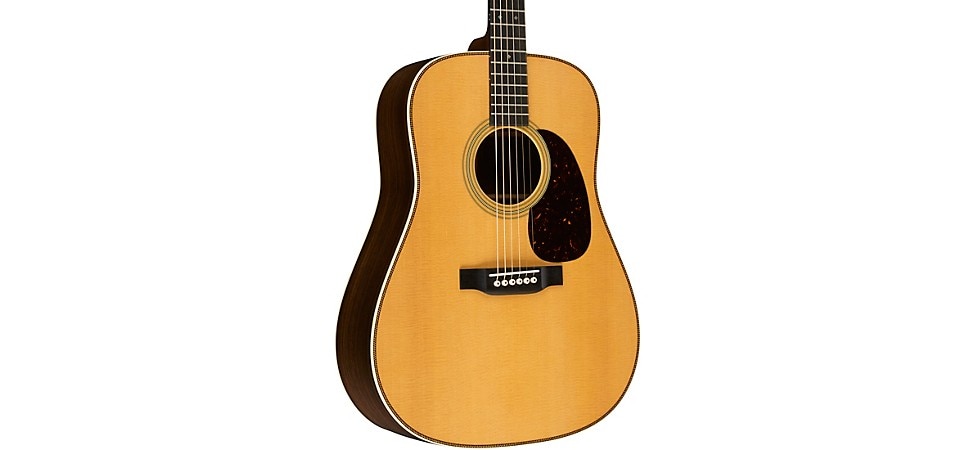
Shop Now: Martin HD-28 Standard Dreadnought Acoustic Guitar
When Martin first created the HD-28 in 1976, it marked the return of vintage looks and construction, with herringbone trim (that's the "H" in "HD") and back strip, plus a tortoiseshell-look pickguard. Scalloped bracing also returned in the HD-28, as many players felt that the lighter weight associated with these braces made for a more responsive top. Over the years since, other vintage features, like the forward-shifted bracing pattern, have returned as well. The HD-28 and the HD-28E acoustic-electric version of the guitar both feature Martin's more modern, Modified Low Oval neck profile, for a feel that's exceedingly comfortable, especially for players who often shift back and forth from acoustic to electric instruments.
Martin HD-28E
Why It’s Cool: Hit the studio or stage with the Martin HD-28E’s organic amplified tones.
Things to Consider:
- Satin neck with High Performance Taper enhances playability
- Golden Era (GE) neck, bracing and bridge design
- Classic big, balanced D-28 tone

Shop Now: Martin HD-28E Standard Dreadnought Acoustic-Electric Guitar
The Martin HD-28E acoustic-electric shares specifications with the regular HD-28 and ups the ante with Fishman Aura VT Enhance electronics to translate its scintillating unplugged voice through onstage amplifiers or in-studio recording devices. As a descendant of coveted, ultrarare D-28 models from the 1930s, the HD-28E incorporates a fast-playing Golden Era Modified Low Oval neck profile; forward-shifted, Golden Era scalloped X-bracing for prominent projection and responsiveness; and a smooth-edged Golden Era Modern Belly bridge style for optimal underhand comfort. If you crave the ability to plug in and get even louder with a D-28’s naturally assertive voice, the Martin HD-28E acoustic-electric guitar ticks all the desirable boxes.
Martin D-28 Authentic 1937 VTS Top
Why It’s Cool: A faithful recreation of a revered vintage acoustic, Martin’s Authentic Series 1937 D-28 pays homage to a mythical production year in the model’s history.
Things to Consider:
- Refined body shape based on 1930s–1940s dreadnoughts
- Sonic profile modeled after museum-grade specimens
- Period-accurate appointments throughout
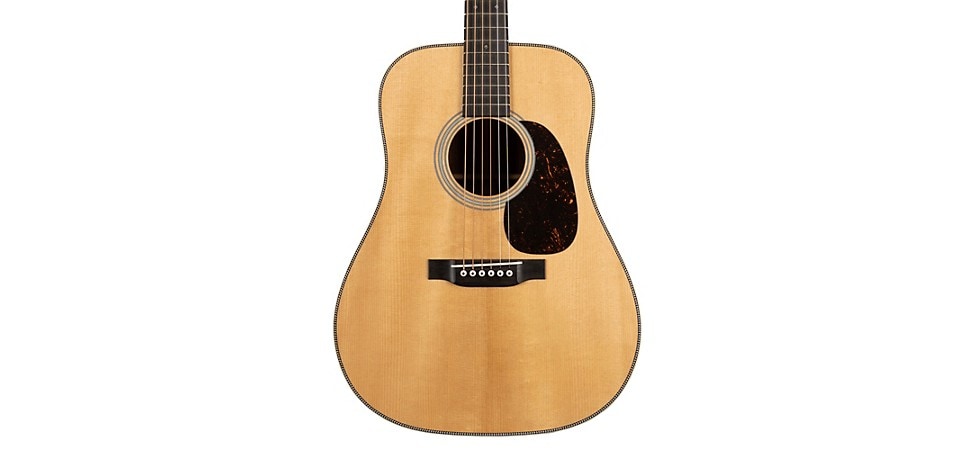
Shop Now: Martin D-28 Authentic 1937 VTS Top Dreadnought Acoustic Guitar
If having a vintage pre-war D-28 is high on your list of dreams, the Martin D-28 Authentic 1937 would pretty much allow you to check that off your list for substantially less than one of the increasingly rare, nearly impossible-to-find original vintage pieces. Thanks to Martin's VTS process (previously discussed) and the museum collection at C.F. Martin & Company, the D-28 Authentic 1937 is, in essence, a clone of one of the finest examples they have. With certified Guatemalan rosewood back and sides; VTS Adirondack spruce top and VTS braces set in the vintage forward-shifted pattern; ebony bridge and fingerboard; and vintage-profile, dovetail-set mahogany neck, the sonic details spring to life. The herringbone purfling and back strip with aged, grained ivoroid binding summon up the classic mid-'30s vibe. Traditional materials, like the bone for the nut and saddle, and hide glue, make the D-28 Authentic almost a time capsule. This is a once-in-a-lifetime guitar for true aficionados of quality acoustic instruments.
Martin Billy Strings Signature D-28
Why It’s Cool: Taking inspiration from his classic 1940 D-28, the Billy Strings signature version features custom specs tailored to his intricate, expressive playing style.
Things to Consider:
- Shorter 25" scale length
- Slightly slimmer nut width (1-23/32")
- Exclusive closed-gear nickel tuners

Shop Now: Martin Billy Strings Signature D-28 Acoustic Guitar
Designed in collaboration with Grammy Award‑winning bluegrass phenom Billy Strings, this signature D‑28 draws inspiration from his prized 1940 model. The 25" scale length slightly reduces string tension, making bends and rapid passages easier, while the 1‑23/32" nut width is just a hair narrower than the typical 1‑3/4", striking a balance between speed and fingerpicking space. Exclusive closed‑gear nickel tuners keep the look classic and the tuning stable, and the overall design captures the feel and sound of Strings’ road‑worn vintage dreadnought.
Closing the Case for the Martin D-28
The D-28 has always been one of those guitars that just seems to be there at critical moments in music history. Its relatively unadorned looks and unsurpassed tone and clarity have made it very much the touchstone in acoustic guitar music. For so many legends, the D-28 was the guitar that became a part of them. Sonically and aesthetically, the D-28 defined what a dreadnought guitar should be, and its spirit lives in every acoustic guitar model that that starts with a "D."
If this article has you closing your eyes and dreaming, rest assured that Guitar Center has the D-28 that's in those dreams, whether it's a custom order from C.F. Martin & Company, a new version that's already hanging on the wall in one of our stores, or in our extensive Used & Vintage collections. Contact your local store or speak with a Gear Adviser to find the model that fits you, and if you’re curious about Martin’s current Standard Series offerings, be sure to check out our ”Guide to Martin’s Standard Series Acoustic Guitars.”
People Also Ask ...
Is the D-28 the Holy Grail of Acoustic Guitars?
Among acoustic players, the D-28 is often referred to as a “holy grail” guitar. It’s not the rarest Martin, nor the most ornate—that title often goes to limited-run pearl-trimmed models like the D-45—but the D-28’s combination of tone, history and cultural presence has given it near-mythic status. For many guitarists, as can be seen by the list that follows, it represents the benchmark by which all other dreadnoughts are measured.
Why the D-28 Commands Its Price
The D-28’s price reflects more than its name. East Indian rosewood back and sides and a select Sitka spruce top deliver the deep bass and shimmering overtones players expect. Built in Martin’s Nazareth, Pennsylvania, factory, each guitar combines CNC precision with handshaped scalloped bracing and dovetail joints. These details, plus the use of bone for the nut and saddle, explain why the D-28 costs more than entry-level acoustics—it’s crafted for tone and longevity, not shortcuts.
Where the Martin D-28 Is Made
Every D-28 is built in Martin’s historic Nazareth, Pennsylvania, factory. Unlike the Road Series, produced in Mexico, the Standard Series guitars are crafted entirely in the U.S. This ensures added consistency, careful quality control and the blend of modern and traditional methods that define the D-28.
How Does the D-28 Compare With Other Martin Dreadnoughts?
While the D‑28 is the archetypal Martin dreadnought—renowned for its rich bass, sparkling highs and balanced tonal clarity—it holds its own particular personality when compared with the D‑18, D‑35 and D‑45.
- D‑18: Built with mahogany back and sides, the D‑18 delivers a punchier, mid‑range‑focused tone—warmer and more direct than the rosewood‑rich D‑28. It’s revered for its suitability in bluegrass and rhythmic playing, offering a bold and free‑spirited voice.
- D‑35: Featuring a three‑piece rosewood back and modified bracing, the D‑35 produces a less “fat” and more bell‑like, finely balanced sound. It often favors strummers, with excellent note separation and a resonant percussive quality—different in character from the D‑28’s fuller projection.
- D‑45: A luxury iteration, the D‑45 builds upon the D‑28’s foundations but incorporates upscale ornamentation and high-end woods that give it a refined aesthetic and tonal elegance. It’s a higher‑grade, more decorative counterpart to the D‑28.
In essence, the D-18 accents warm mid-range drive, the D-35 broadens tonal nuance and playability, while the D-45 elevates craftsmanship and sophistication—all distinct angles on the enduring appeal of the D-28 base.
.jpeg)






